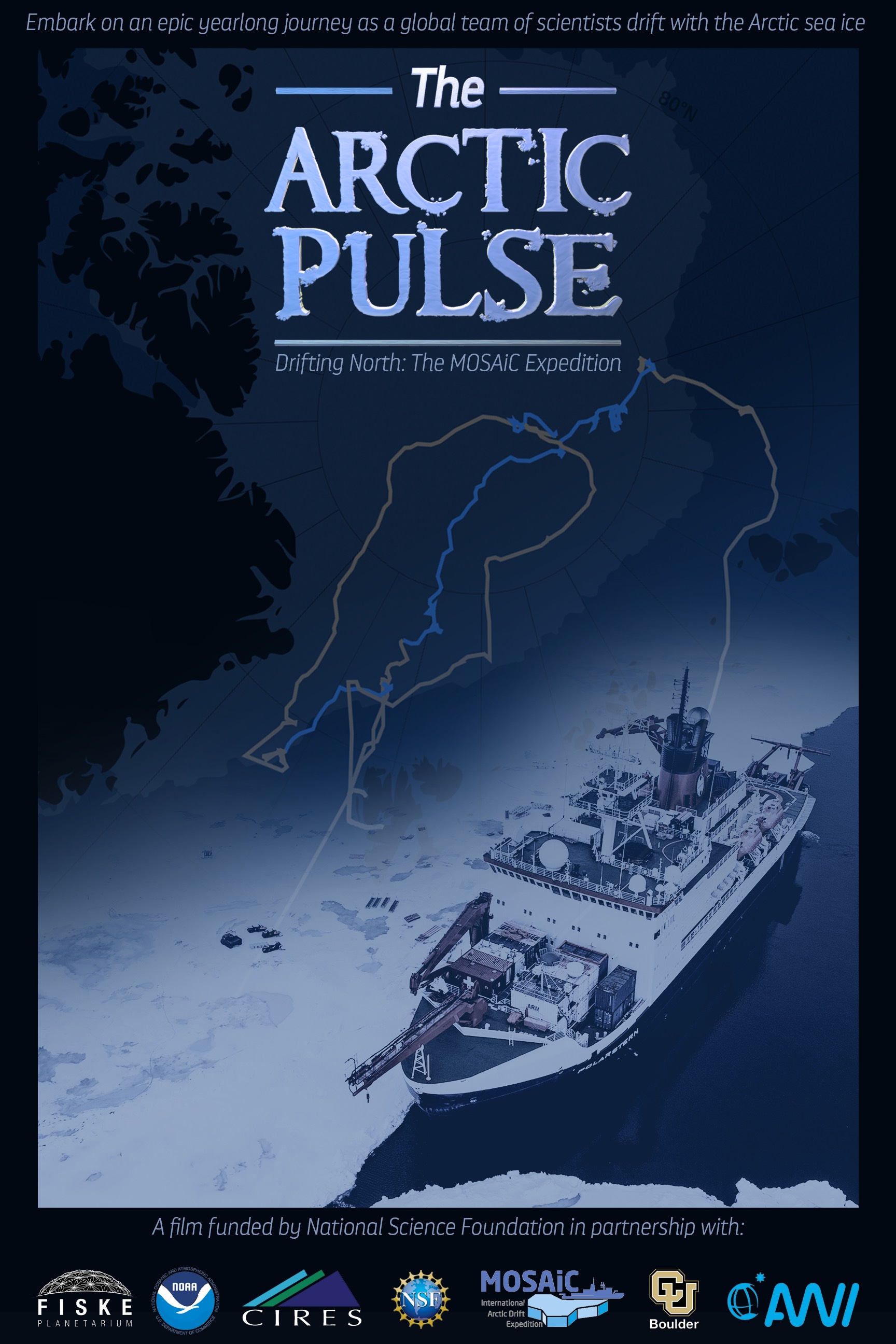Drifting North Polar Planetarium
The Drifting North Polar Planetarium Experience invites students to explore what it was like to participate in the MOSAiC expedition to the North Pole. The unit includes five lessons, five activities, and a 30-minute film.
MOSAiC was an unprecedented international research expedition to study the physical, chemical, and biological processes that couple the Arctic atmosphere, sea ice, ocean, and ecosystem. The German icebreaker Polarstern began MOSAiC’s journey in Tromsö, Norway, sailing north of the Northern Lights and parking against a block of sea ice. The Polarstern drifted with the ice for 13 months, much like the ship of Norwegian explorer Fridtjof Nansen 125 years ago. More than two dozen scientists, engineers, educators, and others from the University of Colorado Boulder and NOAA joined scientists from 16 other nations for the international MOSAiC mission: the Multidisciplinary Drifting Observatory for the Study of Arctic Climate
Visit your local planetarium for a field trip for the full dome experience or facilitate the unit in your classroom using the free 2D film and lesson materials.
Register here to attend a field trip at Fiske Planetarium at CU Boulder
Context for Use
In this MS/HS lesson, students will be transported to the Arctic with the MOSAiC expedition, The Multidisciplinary drifting Observatory for the Arctic Climate, in an immersive classroom and field trip experience.

Student engaging with Polargram station at Fiske Planetarium
Goals Header
What Students Will Do
The Drifting North Polar Planetarium field trip is an immersive experience for learners of all ages to explore the nature of science through the MOSAiC Expedition. Visit the planetarium for a 30-minute full dome film on the expedition or watch the film in your classroom. Classroom lessons can be paired with classroom curriculum and hands-on activities.
Teaching Materials
Description
Classroom Activities
Introduction to the MOSAiC Expedition - Learn about the conditions in the Arctic and the scientists who study them through slides, audio podcast, and a worksheet.
- Driving Question: What is the Arctic? Who studies the Arctic? Why should we care about the Arctic?
- NGSS: Science is a Way of Knowing, Science is a Human Endeavor
- 60 minutes - Middle School
Letters to the Arctic - The film and multimedia project Letters To The Arctic asked scientists to share their narratives and get personal about their relationship with the ice. Explore these letters with your students and prompt them to share their narrative about our ever-changing environment.
- Driving Question: How do scientists feel about the places they study?
- NGSS: Science is a Way of Knowing, Science is a Human Endeavor
- 60 minutes - Middle School
Seasons and Light in the Arctic - This activity explores why we have seasons and changing daylight throughout the year by graphing different daylight hours around the world. Students will have the opportunity to explore why the Arctic’s seasons and daylight are different from other places in the world.
- Driving Question: How do we understand the Arctic light and seasons?
- 60 minutes - Middle School
Sea Ice, The Character (lab) - Compare and contrast the different structures of freshwater ice and seawater ice in this hands-on lab. Learn about what makes sea ice so unique in the Arctic.
- Driving Question: How do we understand the Arctic light and seasons?
- 60 minutes - Middle School/ High School **30 min active prep; 2-4 hrs passive prep (freezing water)
Hands-On Activities
** Contact ceee@colorado.edu for support adapting these activities to your classroom**
Constellations During the Polar Night - Let planetarium staff walk you through the night sky in the Arctic. Can you imagine living in the dark for months at a time?
Q&A with a Scientist - Ask questions live at the planetarium or schedule a virtual Q&A for after your visit. Dependent on speaker availability.
Knot Tying Challenge - Do you have what it takes to work in the Arctic? Learn to tie basic knots then test your skills with by placing your hands in ice water and practicing your knot tying. This activity is used in Polar Safety training around the world.
Polargram - What do you look like next to a polar bear? Try on polar gear from NOAA and pose in the Arctic using a greenscreen.
Build a MOSAiC - Can you find your way around the ice floe? Build a map of the research site with your class.
The Films

The Arctic Pulse by Lianna Nixon
Follow an international team of scientists from over twenty countries who embark on an epic year-long expedition to the Central Arctic, MOSAiC. The Multidisciplinary drifting Observatory for the Arctic Climate (MOSAiC) team froze the German Icebreaker R/V Polarstern into the sea ice for a year. For a year, the team drifts with an ice floe and strives to understand the Arctic climate system and its future.
Drifting North: The Arctic Pulse, by Lianna Nixxon, YouTube
Into the Polar Night by Amy Richman
Step out onto an ice floe in the middle of the Arctic Ocean to watch and listen as scientists race the fading light to set up one of the most ambitious international climate collaborations ever, MOSAiC. The Multidisciplinary Drifting Observatory for the Study of Arctic Climate launched in September 2019. Led by the German Alfred Wegener Institute, the mission froze an icebreaker into the Central Arctic Ocean, to better understand the remote region and its role in global climate and weather patterns.
Drifting North: Into the Polar Night , by Amy Lauren, YouTube


